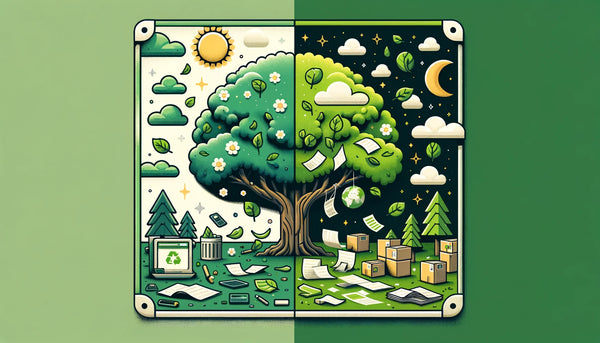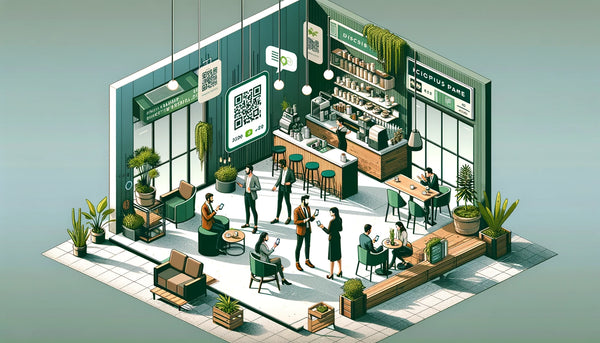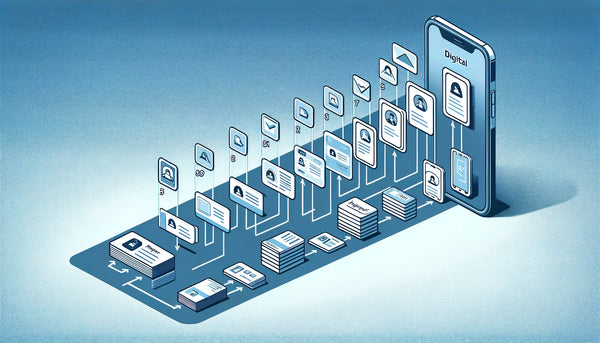The Cost Breakdown: Paper vs. Digital Business Cards

Business cards continue to play an essential role in networking and establishing professional connections.
However, the traditional paper business card is facing increasing competition from its digital counterpart. With advancements in technology, digital business cards have become more prevalent, offering convenience and flexibility.
Many professionals wonder if the digital alternative is a more economical choice in the long run. Let's delve into a comprehensive cost analysis of paper versus digital business cards to help you make an informed decision.
Important Statistics
1. Cost of Paper Business Cards Per Unit: Including shipping and the time employees spend on ordering and designing, paper business cards can cost between $1.5 and $2.5 each, which significantly adds to the overall expenses.
2. Typical Yearly Costs Per Employee for Paper Cards: The annual cost range for paper business cards per employee is between $40 and $80, reflecting the variable expenses associated with different quality and design options.
3. Cost-Efficiency of Sharing Digital Cards: Sharing a Wave digital business card incurs a nominal cost of approximately $0.10 cents per share, offering a cost-effective alternative to the $1.5-$2.5 expense of distributing a paper business card.
4. Annual Cost Range for Larger Companies: For organizations with 500 employees, the yearly expenditure on paper business cards can range from $20,000 to $35,000, highlighting the potential for significant savings with digital alternatives.
5. Enhanced Savings with Digital Options: Organizations can achieve over 26% savings on their business card expenditures by opting for digital over paper, indicating a substantial cost advantage for digital business cards.
6. Annual Expenditure Per Employee on Paper Cards: Businesses on average allocate around $60 annually for each employee's paper business cards, summing up to a hefty annual expense for larger organizations.
7. Material and Design Expenditure: The average material cost for paper business cards per employee stands at approximately $37.95, with design services adding around $6.25 per employee. Moreover, the costs for updating or ordering new cards average $12.52 per employee, and shipping expenses amount to about $7.51 per employee
8. Environmental Considerations: The environmental toll of paper business cards is notable, with their production and recycling processes contributing significantly to deforestation and chemical pollution, respectively. Digital business cards offer a greener alternative with no carbon footprint.
9. Convenience of Digital Card Updates: The ability to instantaneously update digital business cards without incurring extra costs or delays stands in sharp contrast to the cumbersome and often expensive process of updating traditional paper cards
10. Efficiency in Delivery and Usage: Digital business cards eliminate the costs and logistical challenges associated with the physical delivery of paper cards, offering immediate access and distribution digitally
11. Networking Advantages of Digital Cards: Digital business cards streamline the sharing of contact information through QR codes, enhancing the likelihood of effective networking by simplifying the process of saving contact details
12. Comparative Annual Costs for Companies: The financial impact of using paper business cards is significant, with the annual cost per employee averaging $64.23, translating to nearly $6,500 for a 100-person company and over $32,000 for a 500-person organization. Switching to digital can reduce costs to about $48.00 per employee annually.
Comparing the Expenses of Paper vs. Digital Business Cards

Paper business cards are physical, tangible cards that contain essential contact information. They require printing, periodic reordering, and physical storage.
Paper business cards have been a staple in the business world for decades. They are often seen as a professional and traditional way to exchange contact information. However, they come with their own set of challenges and expenses.
Printing costs can quickly add up, especially for businesses that frequently update their contact information or have a large number of employees. Additionally, the need for periodic reordering can be a hassle and an additional expense. Not to mention the physical storage space required to keep a stock of paper business cards.
In contrast, digital business cards are virtual representations of contact information, easily shared via mobile apps or email. They eliminate the need for printing and provide the convenience of instant accessibility.
Understanding the Research Approach

To conduct an accurate cost analysis, we considered various factors involved in using both paper and digital business cards. These factors include initial setup costs, printing expenses, reordering frequency, storage requirements, and accessibility.
We conducted surveys and interviews with professionals from different industries to gather insights into their experiences with both types of business cards. We also analyzed data from businesses that have transitioned from paper to digital cards to understand the financial implications.
Our research approach aimed to provide a comprehensive understanding of the costs associated with paper and digital business cards, taking into account both the upfront expenses and the long-term financial impact.
Key Findings and Insights
Finding 1: Our research indicates that while paper business cards may seem initially cheaper, they incur recurring expenses and pose environmental challenges. Digital business cards offer a sustainable and cost-effective alternative in the long run.
When considering the printing costs, reordering frequency, and storage requirements of paper business cards, the expenses can quickly accumulate over time. On the other hand, digital business cards eliminate these ongoing costs, making them a more financially viable option.
Finding 2: digital business cards have a positive environmental impact. By reducing the need for paper and ink, they contribute to the conservation of natural resources and help minimize waste. This aligns with the growing trend towards sustainability in business practices.
Finding 3: With the rise of smartphones and mobile apps, sharing contact information has become effortless. Digital business cards can be easily shared with a simple tap, eliminating the need for physical exchanges.
In conclusion, while paper business cards have long been the norm, digital business cards offer a more cost-effective and sustainable solution. By eliminating printing costs, reordering hassles, and storage requirements, digital business cards provide a streamlined and eco-friendly way to exchange contact information in today's digital age.
Exploring the Affordability of Digital Business Cards

When evaluating the affordability of digital business cards, we've identified several key advantages:
1. Cost Savings:
Digital business cards eliminate printing costs, reducing expenses significantly. Additionally, they eliminate the need for reordering.
One of the most significant advantages of digital business cards is the cost savings they offer. Traditional printed business cards require regular printing and reordering, which can quickly add up in terms of expenses.
With digital business cards, these costs are eliminated entirely. There is no need to spend money on printing services or worry about running out of cards. This not only saves businesses money but also provides a more sustainable and efficient solution.
2. Convenience and Accessibility:

Digital business cards can be instantly shared with a simple tap or email, increasing networking efficiency.
With a traditional business card, you have to physically hand it to someone or leave it behind at a networking event. This can be cumbersome and may result in lost opportunities if the recipient misplaces or forgets about the card.
However, with digital business cards, you can instantly share your contact information with a simple tap or email. This not only saves time but also ensures that your information is easily accessible to potential clients or business partners. Environmentally Friendly: By eliminating paper waste and reducing the carbon footprint associated with printing, digital business cards are more sustainable.
3. Sustainability:
Traditional printed business cards contribute to paper waste and have a significant carbon footprint due to the printing process. Digital business cards, on the other hand, are environmentally friendly.
By eliminating the need for paper and printing, they help reduce waste and minimize the impact on the environment. This makes them a more sustainable choice for businesses that are conscious of their ecological footprint.
Considering these advantages, digital business cards offer a compelling case for their affordability. Not only do they save costs by eliminating printing expenses, but they also provide convenience, accessibility, and contribute to a more sustainable business practice.
Introducing Wave: Your Digital Business Card Solution

Amidst the increasing popularity of digital business cards, Wave has emerged as a leading solution. Wave provides user-friendly mobile apps that allow professionals to create, manage, and share their digital business cards effortlessly.
The Wave platform offers various customization options, allowing individuals to personalize their cards with unique designs and relevant information. With a wide range of templates and color schemes to choose from, users can create a visually appealing and professional digital business card that represents their personal brand.
But customization doesn't stop at design. Wave also allows users to add multiple contact details, including phone numbers, email addresses, social media profiles, and website links. This ensures that recipients of the digital business card have all the necessary information to get in touch with the professional.
Feature 1: One of the standout features of Wave is its integration with Apple Wallet. This integration streamlines card management, ensuring seamless synchronizations across devices. Users can easily update their contact information on one device, and it will automatically reflect on all their other devices. This eliminates the hassle of manually updating contact details on multiple platforms.
Feature 2: Wave's mobile apps are available for both iOS and Android devices, making it accessible to a wide range of users. The apps are designed with a user-friendly interface, allowing individuals to create and manage their digital business cards with ease.
Feature 3: Wave also offers advanced features such as QR code generation and scanning. Users can generate a unique QR code for their digital business card, which can be easily scanned by others to quickly save their contact information. This eliminates the need for manual data entry and ensures accuracy in saving contact details.
Feature 4: In addition to its user-friendly interface and advanced features, Wave prioritizes data security. The platform employs robust encryption and authentication measures to protect users' sensitive information. Professionals can confidently share their digital business cards, knowing that their data is secure.
Choosing the Perfect Business Card Solution for Your Needs

Simplifying Card Management with Google Wallet Integration
The integration of Wave's digital business cards with Google Wallet brings forth a host of benefits. Professionals can easily manage their contacts, update information, and ensure consistency across platforms. This eliminates the need for manual updates and reduces potential errors.
Sharing Your Digital Business Card Hassle-Free
Sharing business cards is effortless with Wave. Users can simply forward their digital card via email or share it instantly through the Wave app. This eliminates the risk of losing or running out of physical cards during networking events.
Unveiling Wave's Impact: Digital Business Card Trends & Stats 2028

As we look ahead, the future of business cards undoubtedly lies in the digital realm. Statistics show that by 2028, digital business cards are projected to surpass paper cards in terms of usage, further solidifying their economic viability.
In conclusion, while paper business cards have been a staple for decades, digital business cards offer a more economical and sustainable solution. Embracing digital alternatives like Wave can streamline networking efforts, save costs, and contribute to a greener future. So, why not make the switch today?




